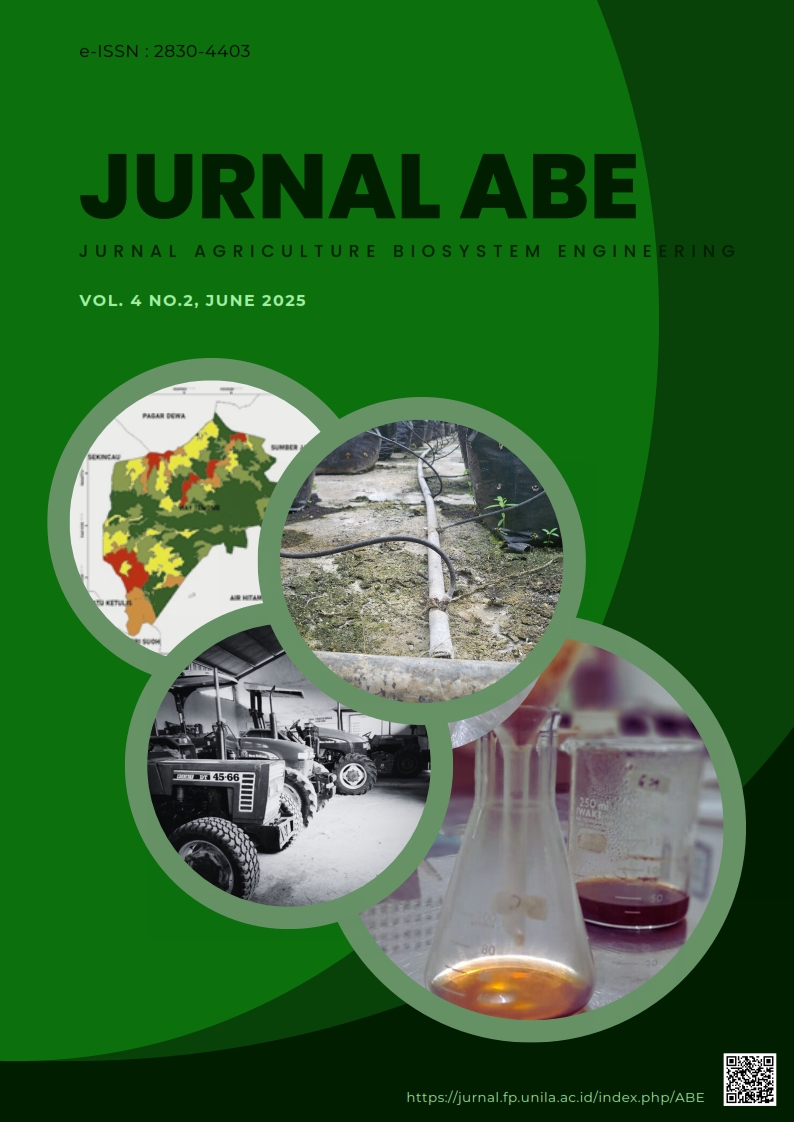Effectiveness of Cassava Harvesting by Applying Harvesting Implement
DOI:
https://doi.org/10.23960/jabe.v4i3.11557 Abstract View: 167
Abstract View: 167
Keywords:
Cassava, Harvesting Implement, Effectiveness, TractorAbstract
Cassava is one of Indonesia’s leading food commodities, especially in Lampung Province. However, cassava harvesting is still predominantly done manually, which is time-consuming, labor-intensive, and prone to crop damage. This study aims to evaluate the effectiveness of cassava harvesting using a Kubota mechanical harvesting implement compared to traditional manual methods. The research was conducted in Bandar Mataram District, Central Lampung Regency, over an area of 0.75 hectares and observed parameters including harvest time, tuber damage, losses, and labor efficiency. Results showed that the harvesting implement significantly improved efficiency, allowing one machine to harvest up to 1.07 hectares per day, compared to only 0.045 hectares per day per person using manual labor. Tuber damage and losses were also reduced from 7% in manual harvesting to 1.59% with the implement. Furthermore, the implement created soil ridges suitable for direct replanting without further tillage. Despite its advantages, some operational weaknesses were identified, such as the need for stem cutting and transportation improvements. Overall, the use of mechanized harvesting tools enhances cassava farming efficiency and has the potential to reduce labor dependency and improve farmer productivity.
Downloads
References
Beja, H.D. and Apelabi. 2019. The effect of planting distance in intercropping patterns of corn and inorganic fertilizer on the growth and production of cassava. Jurnal Pendidikan, sains, dan humaniora. 7(6): 828-842.
Sagala, E. and Suwarto. 2017. Harvest and Post-Harvest Management of Cassava (Manihot esculenta Crantz) as Raw Material for Tapioca Industry in Lampung. Bul. Agrohorti. 5(3): 400-409.
Sundari, S., Pratama, A.P., and Hidayat, G. 2025. Design of an automatic sling system cassava pulling tool for use in the harvesting process. Industrika Jurnal Ilmiah Teknik Industri. 6(2): 93-101.
Pramtiwi, F.E., Murniati, K.M., Iswara, R. 2022. Technical and Economic Efficiency of Cassava in Central Lampung Regency. Jurnal Pemikiran Masyarakat Ilmiah Berwawasan Agribisnis. Januari 2022. 8(1): 118-131.
Wijayanto, B. and Puspitojati, E. 2024. Optimizing Agricultural Mechanization to Enhance The Efficiency and Productivity of Farming In Indonesia: A Review. Asian Journal of Applied Research for Community Development and Empowerment. 8(3): 209-217.
Downloads
Published
How to Cite
Issue
Section
License
Copyright (c) 2025 Warji Warji, Sandi Asmara, Kuswanta Futas Hidayat, Purba Sanjaya, Teguh Endaryanto

This work is licensed under a Creative Commons Attribution-NonCommercial-ShareAlike 4.0 International License.
Authors who publish with this journal agree to the following terms:
Authors retain copyright and grant the journal right of first publication with the work simultaneously licensed under a Creative Commons Attribution-ShareAlike 4.0 International Lice that allows others to share the work with an acknowledgement of the work's authorship and initial publication in this journal.
Authors are able to enter into separate, additional contractual arrangements for the non-exclusive distribution of the journal's published version of the work (e.g., post it to an institutional repository or publish it in a book), with an acknowledgement of its initial publication in this journal.
Authors are permitted and encouraged to post their work online (e.g., in institutional repositories or on their website) prior to and during the submission process, as it can lead to productive exchanges, as well as earlier and greater citation of published work (See The Effect of Open Access).
Jurnal Agricultural Biosystem Engineering

JABE is licensed under a Creative Commons Attribution-ShareAlike 4.0 International License.




